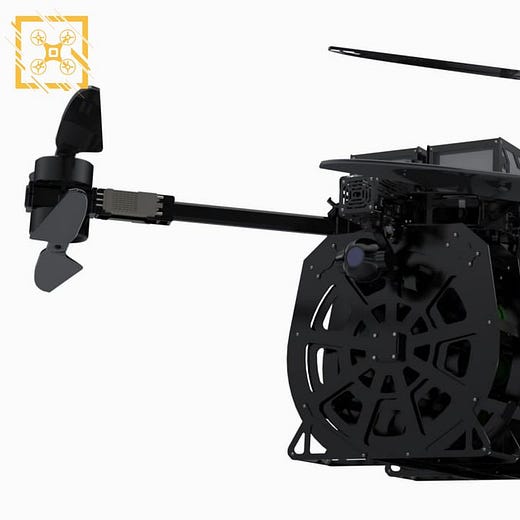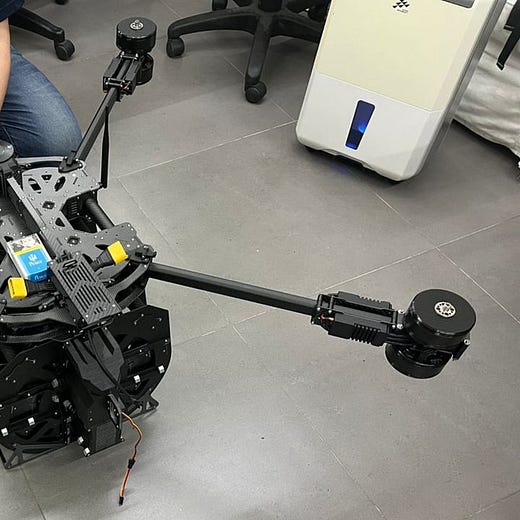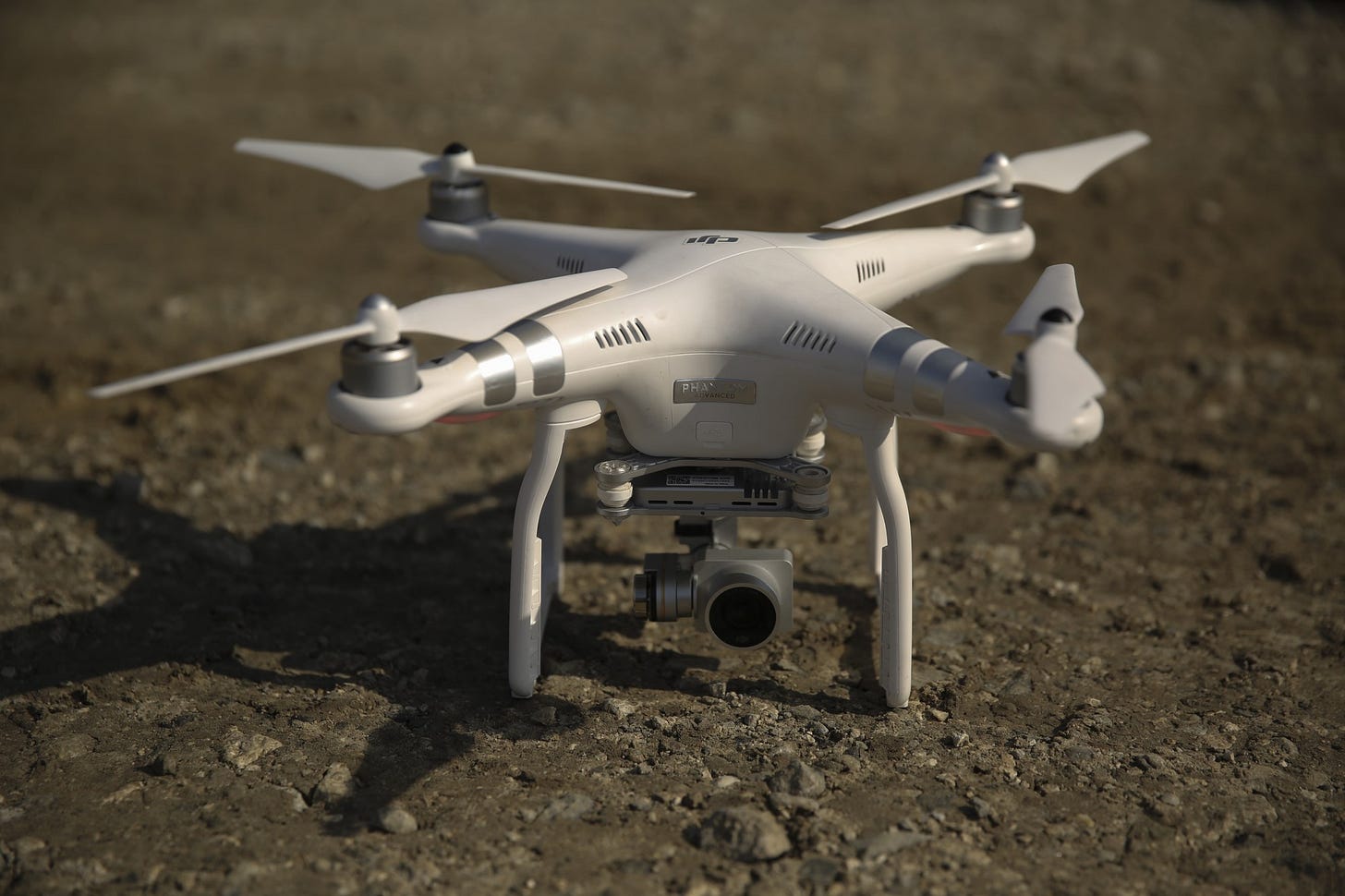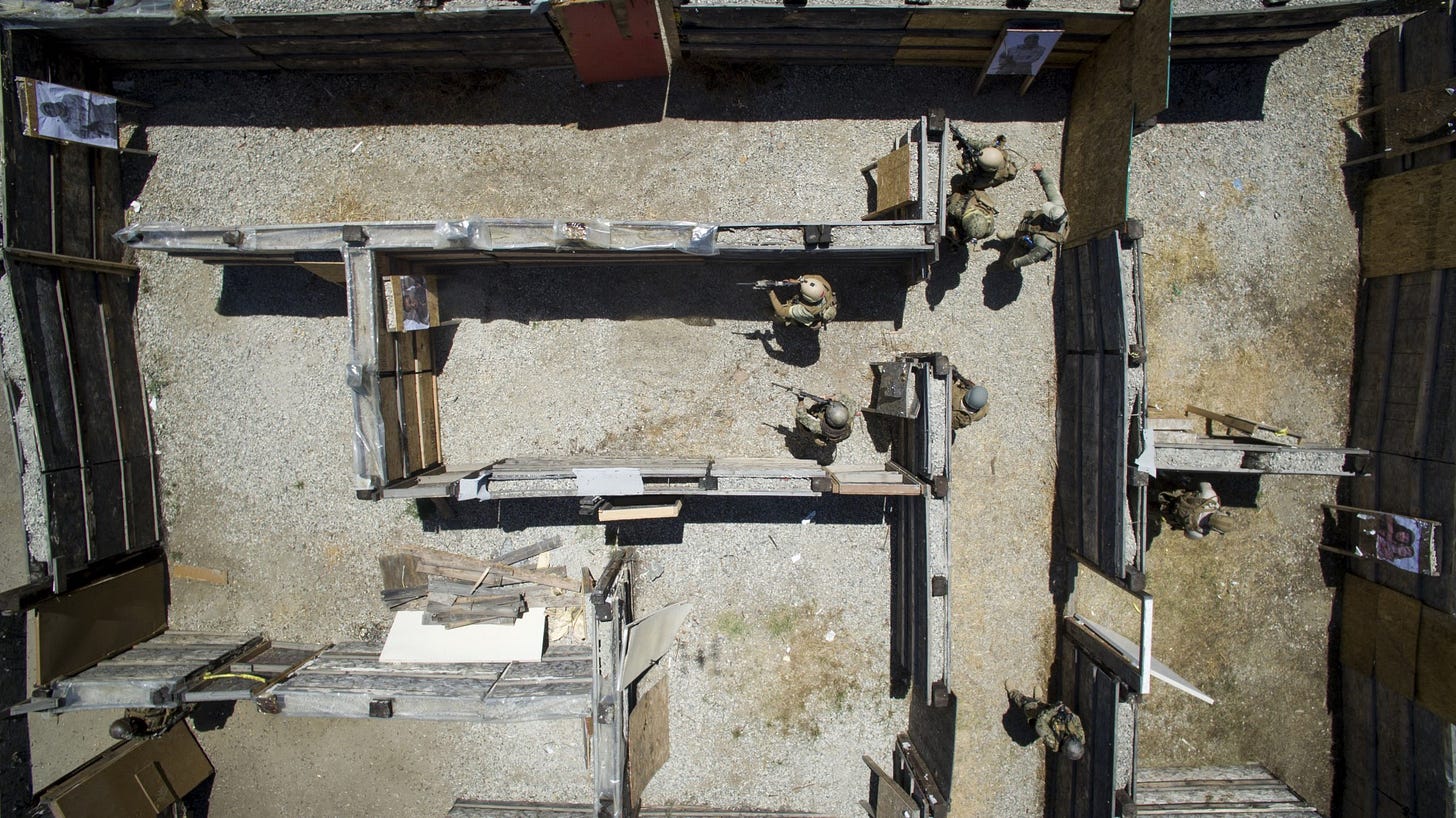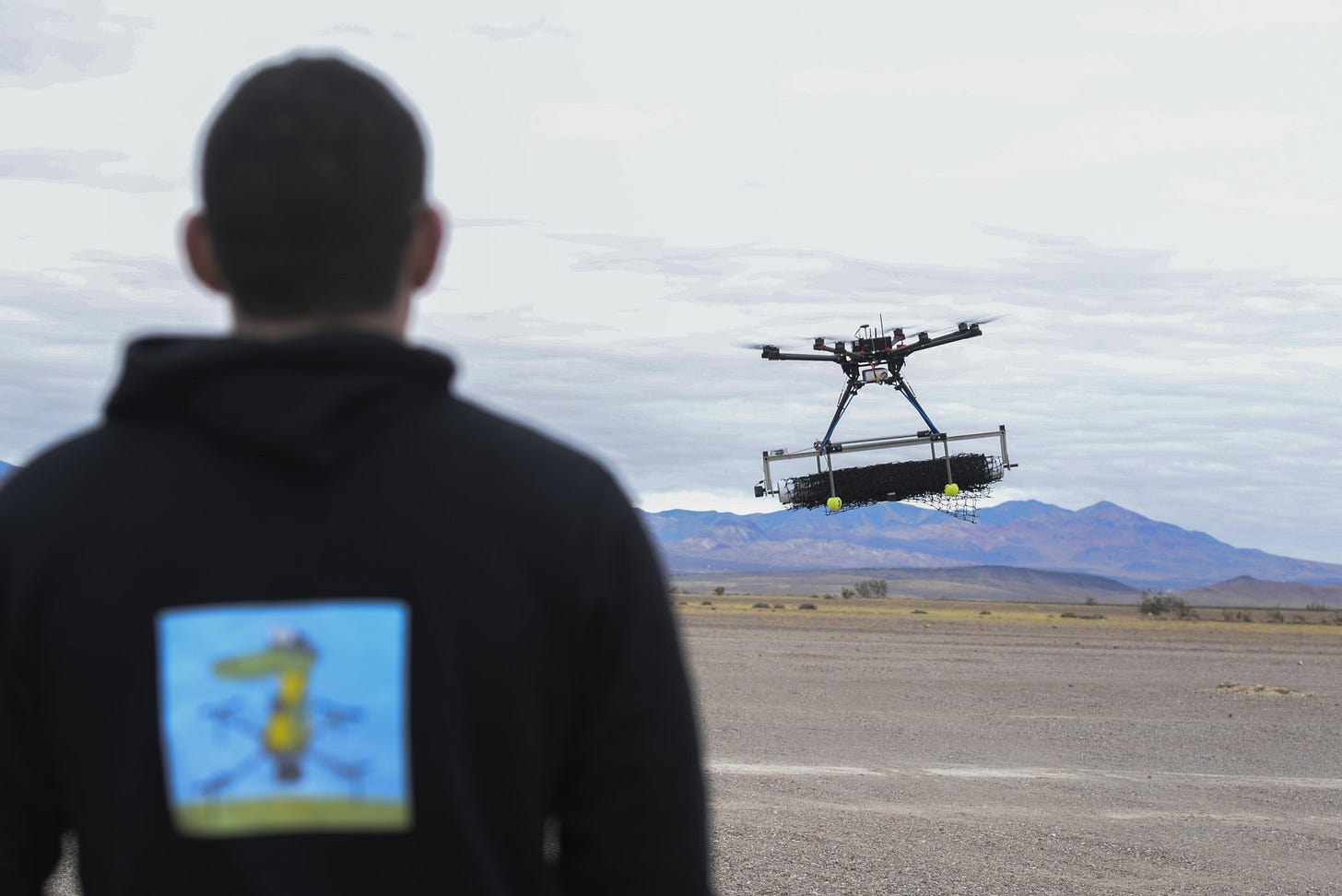Duel Use
Consumer electronics at war
Edited by Althea May Atherton
In mid-May, people started tagging me in the tweet below about a drone. Well, not a drone exactly: a weapon delivery system carried by a drone. A 14-second video showed the device suspended by pink straps between the legs of a ladder as the internal chamber of a clunky black carousel rotates. The video showed no actual drones, just a small yellow quadcopter watermark in the upper left corner. With a whirr and a ka-chunk, a mortar round falls onto the foam and bubble wrap padding below, again and again until it has spun seven times.
“It was once said that consumer and industrial drones are toys. They should not be taken into account. And as history shows, experts love to be wrong.,” reads the Telegram post that accompanies the video. (Originally in Russian, wording here via Google translate). “The other day I stumbled upon the next stage in the development of drones as a tool of war. In this short video, engineers from the Netherlands have developed a drum system for dropping mortar shells. Run-in will be carried out in Ukraine.”
I do not know the origin of this mortar-carousel. If I did, this story would probably appear in a much more conventional form at another outlet, a tidy description of how the weapon was made, what drones it goes with, and maybe even an example of hypothetical battlefield use.
The best version of that story, at least as I have seen so far, exists at The War Zone, and was written by Emma Helfrich
“In terms of the quadcopter-mounted drum magazine, it's possible that we may have already seen a prototype version in use by Ukrainian forces,” writes Helfrich, before describing a video clip“reportedly taken using a camera on a weaponized commercial drone, is said to show an attack on a Russian T-72B3 tank involving four mortar rounds dropped in relatively quick succession.”
Commercial drones have for years been used to place explosives on people and vehicles in war. (The implications for terror attacks or assassinations have so far been, despite fears, much more limited in practice). ISIS, the insurgency that became a territorial power across Iraq and Syria before being beaten back, armed drones in multiple ways, from booby-trapping scouts to assembling a factory of homebrew flying robots to even attaching shuttlecock feathering to grenades so that they would fall more accurately when dropped from drones.
Ukraine, too, has seen its share of commercial drones adapted for war as scouts and ultralight bombers. This is, broadly, what modern commercial drones offer militaries. While model airplanes, radio control, and uncrewed planes are not new, modern ones pair the cheap and highly capable electronics that grew up around smartphones. Never before in history has it been so easy to put a flying camera into the air and watch it remotely, which is a fun trick for film or photography and an incredibly powerful tool of war.
Something that has set commercial drones apart in this regard is that much of the development, iteration, and cost reduction at scale has happened in tools designed for business and hobbyist use, while drones specifically marketed at the military have retained high price tags, small-batch production, and complex security requirements.
In 2013, when I had just started in journalism and was living in DC, a friend asked if I had any ideas for what kind of hobbyist drone kit his squad should buy for their wargame at the Marine Corps officer training course. I didn’t know the market yet, and it’s to my eternal regret that I never followed along for the mission, but they bought a hobbyist drone kit, put it into the field, and trained with drones as kit purchased from their exercise’s little optional budget.
A few years later, I had the opportunity to watch a training exercise with sanctioned toy drone use, where West Point cadets marched into the mostly hyperbolically described “urban warfare environment” and had to meet up with a commander carrying an anti-drone rifle. The drone used for the defenders was a Parrot quadcopter, a cheap camera-carrying toy model, and the rules of the exercise stated that it could be used to call in simulated artillery strikes if it saw soldiers before it was disabled. The first run-through heeded this lesson and disabled the drone first, but the second batch decided to advance machine gunners through tall grass before knocking out the drone, a call that proved disastrous for their run.
Through this era, and up until 2018 proper, the US military has struggled to figure out how to handle the utility and low cost of cheap drones, while sometimes quietly and other times loudly acknowledging a distrust of the systems because DJI, the largest hobbyist drone company, is headquartered in China, and many of the crucial parts for making drones are also made there. In 2018, a series of Department of Defense Inspector’s General reports claimed that cybersecurity vulnerabilities meant the use of drones made in China carried an undue national security risk and could only be approved through an extensive waiver process. In 2020, Congress passed a law mandating certain drone parts not be made in China if the drone is to enter military use.
This back-and-forth on contracting was the focus of a story I wrote for Popular Science this month, largely about how security fears and Pentagon spending created a market for “BlueUAS”, or US-approved commercial drones. It’s industrial policy pretending it isn’t industrial policy. The ultimate goal is for the US to have its own commercial drone parts ecosystem, supplied by American companies and others that meet some threshold of security cooperation, all so that troops in the field can get close to the same effect as militaries fighting in Ukraine are getting straight off the shelf.
Ultimately, the story of the mortar-magazine carrying drone isn’t really about the drone. And sufficiently powerful quadcopter or octocopter could mount that magazine below, and with a minimum of controls and probably just a single plug-and-play connection, a normal control station or even smartphone could be used to target and drop the bombs.
Drones, for as much as they are a unique modern phenomena I’ve built my career around describing, are fundamentally dual-use technologies. They’re a good airframe for holding sensors and other cargo. Often those sensors are cameras and sometimes that cargo is a rig that allows for the dropping of multiple explosives.
The story of dual-use technology isn’t really about unique threats or vulnerabilities thanks to what country is making the parts. It’s about how capable modern machines are, and what can be done with tools produced at commercial scale.
To emphasize this, I’m going to tell the story a second time.
In 2014, I wrote DARPA exploring a hybrid motorcycle that could use both electric and gasoline power. The bike sought was a specialized tool, one that could operate on a range of fuel sources and away from regular resupply, all while producing sounds of just 55 decibels in electric mode. In 2017 I revisited this story, and the motorcycle had a name: SilentHawk. Last fall, I picked up a different but similar story: the Australian military was testing a commercial ebike model, to see if it could offer scouts a silent way to go anywhere a bike can go. (Australia did not name the model or maker of the ebike).
This week, images came out from Ukraine of soldiers there using a commercial ebike model and attaching the NLAW anti-tank weapon to it.
Mounting big anti-tank weapons to cheaper lighter vehicles isn’t new. (I’m partial to the Vespa with a recoilless rifle, myself), but what this demonstrates is that for the actual task at hand, the straightforward commercial tech got there first, was available in an accessible way, and is now part of how this war is being fought and how future wars are being fought.
Dual use, for duel use.
Thank you all for reading! I’m grateful for the opportunity to write for you, and every month sustained by your generosity.
Since the start of March, I have been writing the Critical State newsletter from The World and Inkstick Media. At the center of each of those newsletter, I take a dive into recent academic work related, broadly, to foreign policy, and the archive of those newsletter essays can be found here. I think the newsletters stand on their own, but they also provide me with an experience every columnist needs: homework in which I read other better smarter writers.
Thanks for sticking with Wars of Future Past, and I look forward to writing many more stories for y’all. As always, if you have any feedback, feel free to reach out to Kelsey at warsoffuturepast@gmail.com and Althea at athertongazetteer@gmail.com.



